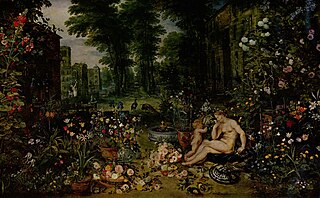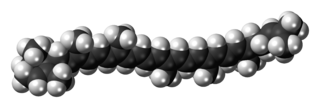
Carotenoids, also called tetraterpenoids, are yellow, orange, and red organic pigments that are produced by plants and algae, as well as several bacteria and fungi. Carotenoids give the characteristic color to pumpkins, carrots, corn, tomatoes, canaries, flamingos, and daffodils. Carotenoids can be produced from fats and other basic organic metabolic building blocks by all these organisms. The only animals known to produce carotenoids are aphids and spider mites, which acquired the ability and genes from fungi or it is produced by endosymbiotic bacteria in whiteflies. Carotenoids from the diet are stored in the fatty tissues of animals, and exclusively carnivorous animals obtain the compounds from animal fat. In the human diet, absorption of carotenoids is improved when consumed with fat in a meal. Cooking carotenoid-containing vegetables in oil increases carotenoid bioavailability.

α-Carotene is a form of carotene with a β-ionone ring at one end and an α-ionone ring at the opposite end. It is the second most common form of carotene.

An aroma compound, also known as an odorant, aroma, fragrance, or flavor, is a chemical compound that has a smell or odor. A chemical compound has a smell or odor when it is sufficiently volatile to be transported to the olfactory system in the upper part of the nose.
Iron is a chemical element with symbol Fe and atomic number 26.

cis-3-Hexen-1-ol, also known as (Z)-3-hexen-1-ol and leaf alcohol, is a colorless oily liquid with an intense grassy-green odor of freshly cut green grass and leaves. It is produced in small amounts by most plants and it acts as an attractant to many predatory insects. cis-3-Hexen-1-ol is a very important aroma compound that is used in fruit and vegetable flavors and in perfumes. The yearly production is about 30 tonnes.

cis-3-Hexenal, also known as (Z)-3-hexenal and leaf aldehyde, is colorless liquid and an aroma compound with an intense odor of freshly cut grass and leaves. It is one of the major volatile compounds in ripe tomatoes. It is produced in small amounts by most plants and it acts as an attractant to many predatory insects. It is also a pheromone in many insect species.

Citral, or 3,7-dimethyl-2,6-octadienal or lemonal, is either a pair, or a mixture of terpenoids with the molecular formula C10H16O. The two compounds are double bond isomers. The E-isomer is known as geranial or citral A. The Z-isomer is known as neral or citral B.

Decalin, a bicyclic organic compound, is an industrial solvent. A colorless liquid with an aromatic odor, it is used as a solvent for many resins or fuel additives. It is the saturated analog of naphthalene and can be prepared from it by hydrogenation in the presence of a catalyst. Decahydronaphthalene easily forms explosive organic peroxides upon storage in the presence of air.
1,2-Dichloroethene, commonly called 1,2-dichloroethylene or 1,2-DCE, is an organochloride with the molecular formula C2H2Cl2. It is a highly flammable, colorless liquid with a sharp, harsh odor. It can exist as either of two geometric isomers, cis-1,2-dichloroethene or trans-1,2-dichloroethene, but is often used as a mixture of the two. They have modest solubility in water. These compounds have few industrial applications, although they are fundamental given their simple stoichiometries.

Carotenoid oxygenases are a family of enzymes involved in the cleavage of carotenoids to produce, for example, retinol, commonly known as vitamin A. This family includes an enzyme known as RPE65 which is abundantly expressed in the retinal pigment epithelium where it catalyzed the formation of 11-cis-retinol from all-trans-retinyl esters.

In enzymology, β-carotene 15,15'-dioxygenase (EC 1.13.11.63) is an enzyme with systematic name beta-carotene:oxygen 15,15'-dioxygenase (bond-cleaving). In human it is encoded by the BCO1 gene. This enzyme catalyses the following chemical reaction

Benzyl salicylate is a salicylic acid benzyl ester, a chemical compound most frequently used in cosmetics as a fragrance additive or UV light absorber. It appears as an almost colorless liquid with a mild odor described as "very faint, sweet-floral, slightly balsamic" by those who can smell it, but many people either can't smell it at all or describe its smell as "musky". Trace impurities may have a significant influence on the odour. It occurs naturally in a variety of plants and plant extracts and is widely used in blends of fragrance materials.

Damascenones are a series of closely related chemical compounds that are components of a variety of essential oils. The damascenones belong to a family of chemicals known as rose ketones, which also includes damascones and ionones. beta-Damascenone is a major contributor to the aroma of roses, despite its very low concentration, and is an important fragrance chemical used in perfumery.

An odor, or odour, is caused by one or more volatilized chemical compounds that are generally found in low concentrations that humans and animals can perceive by their sense of smell. An odor is also called a "smell" or a "scent", which can refer to either a pleasant or an unpleasant odor.

Olfaction is a chemoreception that forms the sense of smell. Olfaction has many purposes, such as the detection of hazards, pheromones, and food. It integrates with other senses to form the sense of flavor.

δ-Carotene or ε,ψ-carotene is a form of carotene with an ε-ring at one end, and the other uncyclized, labelled ψ (psi). It is an intermediate synthesis product in some photosynthetic plants between lycopene and α-carotene (β,ε-carotene) or ε-carotene (ε,ε-carotene). δ-Carotene is fat soluble. Delta-carotene contains an alpha-ionone instead of a beta-ionone ring; this conversion is carried out by the gene Del which shifts the position of the double bond in the ring structure. The formation delta-carotene under the presence of the Del gene is sensitive to high temperatures.

6-Nonenal is an organic compound with the formula C2H5CH=CH(CH2)4CHO. Other isomeric nonenals are also known to exist naturally, e.g. 2-nonenal. The cis-isomer of 6-nonenal is often listed as the principal component in the aromas of muskmelon fruits. The trans-isomer is listed as an off-flavor aroma of milk foams, and thought to be a possible polypropylene odorant.
9-cis-beta-carotene 9',10'-cleaving dioxygenase (EC 1.13.11.68, CCD7 (gene), MAX3 (gene), NCED7 (gene)) is an enzyme with systematic name 9-cis-beta-carotene:O2 oxidoreductase (9',10'-cleaving). This enzyme catalyses the following chemical reaction




















